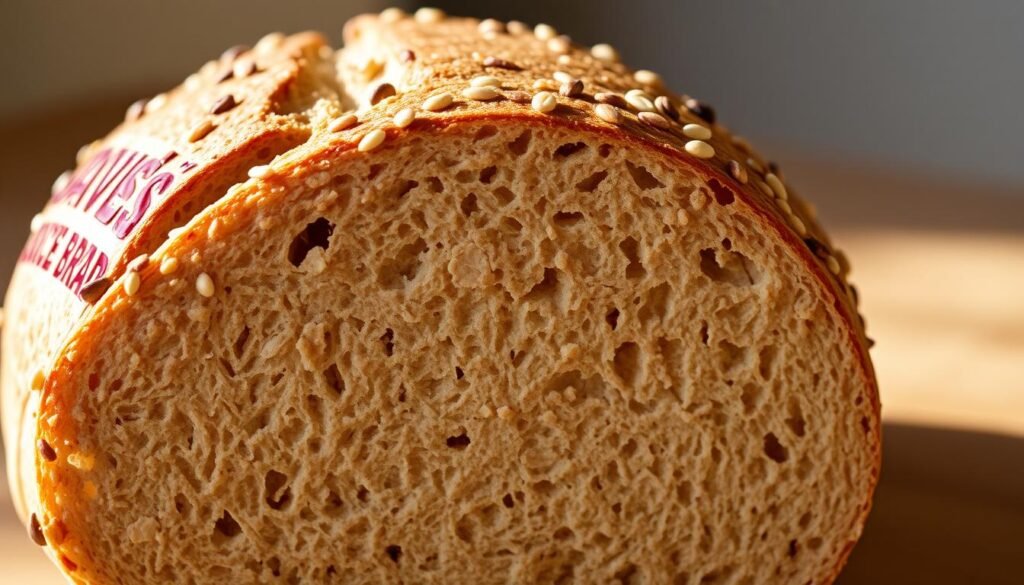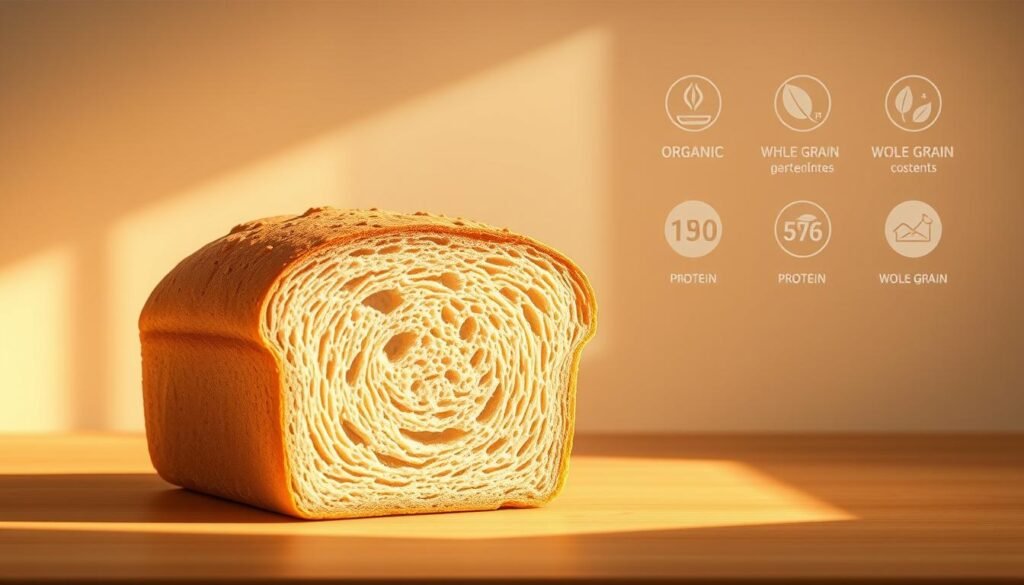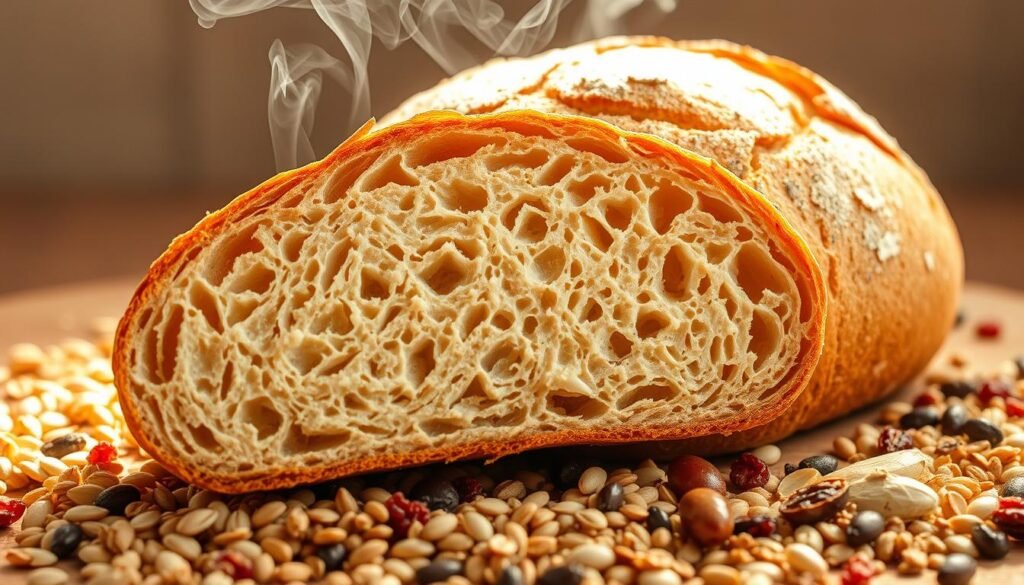Can a loaf packed with whole grains truly support your fitness goals? Many health-conscious consumers wonder if certain brands live up to their claims. With 5g of fiber and 5g of protein per slice, Dave’s Killer Bread 21 Whole Grains variety seems promising. But is it the right choice?
Registered Dietitian Jamie Rothermich analyzed its nutritional profile—110 calories and 5g added sugar per slice. While the fiber content aids digestion, the sugar raises questions. Conflicting opinions swirl around its role in balanced diets.
Does this popular option align with wellness objectives? Let’s break down the facts.
Key Takeaways
- Each slice contains 110 calories, balancing energy intake.
- High fiber (5g) promotes fullness and digestive health.
- Protein content (5g) supports muscle maintenance.
- Added sugar (5g) may impact blood sugar levels.
- Dietitian-reviewed for informed decisions.
Introduction: What Makes Dave’s Killer Bread Stand Out?
Few bakery brands combine social impact with premium ingredients like this Oregon-based company. Founded in 2005 by Dave Dahl, Dave’s Killer Bread revives family bakery traditions with a twist—its team includes formerly incarcerated individuals, offering stable employment.

The USDA Organic and non-GMO certifications ensure quality, while its organic whole wheat base delivers nutrition. Beyond classic loaves, the lineup now features bagels and buns, all packed with visible whole grains seeds for texture and fiber.
Compared to plain white options, this brand prioritizes substance over fluff. Each slice bursts with flax, sunflower, and sesame seeds—a crunchy contrast to bland competitors. It’s not just bread; it’s a statement on reinvention and nourishment.
“Our recipe? Second chances and uncompromised ingredients.”
Dave’s Killer Bread: A Nutritional Deep Dive
Understanding the nutritional value of your daily bread helps make smarter dietary choices. This brand stands out with its commitment to organic ingredients and visible whole grains. Let’s explore what makes each slice unique.
Key Ingredients and Their Health Benefits
Organic whole wheat flour forms the base, offering more fiber than refined alternatives. Packed with ancient grains like spelt and quinoa, it delivers a protein boost. Sunflower seeds add crunch and vitamin E, while flaxseeds contribute omega-3s.

Nutritional Breakdown: Calories, Fiber, and Sugar per Slice
One slice of the 21 Whole Grains variety provides:
- 110 calories: Moderate energy for balanced diets.
- 5g fiber: Supports digestion and satiety.
- 5g added sugar: Less than many sweetened loaves.
Organic vs. Conventional Bread: What’s the Difference?
USDA organic certification ensures no synthetic pesticides or GMOs. Conventional options often use preservatives like calcium propionate. See how they stack up:
| Factor | Organic | Conventional |
|---|---|---|
| Pesticide Residue | None | Detected in 70% of samples* |
| Shelf Life | Shorter (no preservatives) | Extended (chemical additives) |
| Cost | Higher | Lower |
*Source: USDA Pesticide Data Program. Organic farming also reduces environmental harm by avoiding synthetic fertilizers.
Is Dave’s Killer Bread Good for Weight Loss?
Fiber-rich options like this one can play a key role in satiety and calorie control. With 5g per slice, the fiber content helps slow digestion, keeping hunger pangs at bay. Dietitian Jamie Rothermich notes this meets 20% of daily fiber goals in just two slices.

Compared to white bread, each slice has moderate calories (110) but packs more nutrients. A sandwich with two slices totals 220 calories—similar to alternatives but with better fullness signals. For balanced meals, pair it with lean proteins like turkey or avocado.
| Factor | Whole Grain | Refined White |
|---|---|---|
| Glycemic Index | Low (55) | High (75) |
| Fiber per Slice | 5g | 1g |
| Satiety | High | Low |
Watch the sugar content—5g per slice adds up quickly. Two slices in a sandwich reach 10g, nearing half the daily limit for some diets. Opt for open-faced versions or lower-sugar varieties to stay on track.
Portion control matters. One slice with nut butter makes a satisfying snack, while two work for meals. Balance is key—this loaf offers tools for weight loss, but mindful eating seals the deal.
Pros and Cons of Dave’s Killer Bread
Not all loaves are created equal—some offer more than just empty carbs. This brand’s high-fiber content and organic ingredients make it a standout, but a few trade-offs deserve attention.
Pros: High Fiber, Whole Grains, and Organic Ingredients
Each slice packs 5g of fiber, nearly 20% of daily needs. Visible seeds like flax and quinoa add crunch and nutrients. The USDA Organic label ensures no synthetic pesticides or GMOs.
Compared to refined white options, this loaf keeps you fuller longer. Its whole grains support steady energy levels, making it a smart pick for active lifestyles.
Cons: Added Sugar and Price Point
One slice contains 5g of sugar—equivalent to an Oreo cookie. For two slices, that’s 10g, nearing half the American Heart Association’s daily limit.
At $5.99 per loaf, it costs double conventional brands. However, the preservative-free formula means shorter shelf life. Availability varies, with some rural areas stocking fewer options.
“Balance is key. Pair it with protein to offset sugar spikes.”
For those watching sugar intake, lower-sugar varieties might be wiser. Yet, if budget allows, the nutrient content justifies the splurge for many.
Comparing Dave’s Killer Bread Varieties
With multiple varieties on the shelf, choosing the right loaf requires careful consideration. Each option offers distinct textures, nutrient profiles, and sweetness levels tailored to different dietary needs.
21 Whole Grains and Seeds vs. Thin-Sliced Options
The classic 21 Whole Grains boasts visible seeds and hearty texture. Thin-sliced versions provide the same nutrients with fewer calories per serving.
Key differences:
- Calorie density: Thin slices save ~20 calories per serving
- Seed visibility: Original shows more whole grains
- Versatility: Thinner slices work better for delicate sandwiches
Powerseed Bread: The Healthiest Choice?
This variety swaps cane sugar for apple and peach fruit juice concentrate, reducing sugar to 3g per slice. Antioxidant-rich seeds like pumpkin and sunflower add nutritional value.
Why it stands out:
- Diabetic-friendly: Lower glycemic impact than sweetened versions
- Protein boost: Extra seeds increase plant-based protein
- Taste test winner: Consumers report less sweetness fatigue
Limited availability in some regions makes this healthiest pick harder to find. Check local organic sections or request stock at your grocery store.
How Dave’s Killer Bread Fits into a Balanced Diet
Balanced meals require smart carb choices—this loaf delivers nutrients without empty calories. Dietitians recommend pairing it with protein and healthy fats for sustained energy. Here’s how to integrate it seamlessly into your day.
Breakfast Combinations
Start strong with avocado smash on toasted slices. Add scrambled eggs for a protein boost. The combo balances carbs, fats, and amino acids.
| Meal | Ingredients | Nutrition Ratio |
|---|---|---|
| Power Breakfast | 1 slice + ½ avocado + 2 eggs | 30g carbs / 20g protein / 15g fat |
| Quick Option | 1 slice + almond butter + banana | 35g carbs / 8g protein / 10g fat |
Lunch and Post-Workout Pairings
Pack a turkey-and-spinach sandwich for lunch. Post-gym, try a slice with Greek yogurt and berries. These dietary combos optimize recovery and fullness.
“Whole grains anchor meals by slowing digestion. Pair them with colorful veggies for micronutrients.”
Mediterranean Diet Alignment
This loaf mirrors Mediterranean principles: whole food, minimal processing, and plant-based fats. Swap white bread in recipes for better fiber intake.
- Greek Salad Sandwich: Hummus, cucumbers, olives.
- Fish & Greens: Sardines on toast with arugula.
Expert Opinions: What Dietitians Say
Professional evaluations reveal surprising truths about popular whole grain options. Registered dietitian Jamie Rothermich highlights the 5g fiber content in her YouTube analysis: “This meets 20% of daily needs per two slices—fantastic for digestive health.”
The American Diabetes Association confirms whole grains help regulate blood sugar levels. Their 2023 position paper recommends options like these over refined flour products. However, they caution about added sugars in some varieties.
Celiac Foundation warnings appear on every package. “While nutritious, this product contains gluten,” states their website. Those with sensitivities should explore certified gluten-free alternatives instead.
“Powerseed’s fruit-juice-sweetened formula makes my top five picks for active clients. The nutrient density supports workout recovery.”
Marathon runner testimonials praise the sustained energy. One athlete notes: “I switched to seeded varieties during training—better stamina and less crash.”
The professional consensus? When chosen wisely, these loaves deliver quality nutrition. Pair with proteins and veggies for balanced meals that fuel your day.
Dave’s Killer Bread vs. Other Popular Brands
When comparing bread brands, ingredient quality separates the best from the rest. Most supermarket options prioritize shelf life over nutritional value, but some stand out for cleaner formulations.
Nutritional Comparison with White and Whole Wheat
Standard white bread lacks the fiber and protein found in whole grain varieties. See how they measure up:
| Brand | Fiber (per slice) | Added Sugar | Preservatives |
|---|---|---|---|
| Dave’s 21 Whole Grains | 5g | 5g | None |
| Standard White | 1g | 3g | 3+ types |
| Generic Whole Wheat | 3g | 2g | 1-2 types |
What’s Really in Your Loaf?
Many conventional brands use these common additives:
- Calcium propionate (linked to ADHD symptoms in some studies)
- DATEM (dough conditioner with potential health risks)
- Azodicarbonamide (banned in Europe but allowed in U.S. bread)
Natural alternatives like cultured wheat or vinegar appear in cleaner formulations. Always check labels for hidden ingredients that might affect your dietary needs.
Those with gluten sensitivities should note that most varieties contain wheat. For certified organic options, look for the USDA seal—only 12% of commercial breads meet this standard.
Potential Drawbacks and Who Should Avoid It
While nutrient-dense, this product isn’t ideal for everyone. Some ingredients and processing methods may pose risks for sensitive groups. Always check labels if you have dietary restrictions.
Added Sugar Concerns for Diabetics
Each slice contains 5g of sugar, which can spike blood glucose. Diabetics should monitor portions or opt for unsweetened varieties. Pairing with protein (e.g., nut butter) helps stabilize absorption.
Gluten Sensitivity and Allergen Warnings
Made with wheat, this loaf isn’t safe for celiac disease. Shared equipment with tree nuts raises cross-contamination risks. Major allergens include:
- Gluten (wheat, barley, rye)
- Sesame seeds
- Tree nuts (via facility exposure)
For gluten-free alternatives, consider brands like Canyon Bakehouse or Schär. Their certified options eliminate gluten entirely, catering to stricter diets.
“Always verify ‘gluten-free’ labels—some products still test above safe thresholds.”
Where to Buy and How to Store for Freshness
Proper storage methods can extend the shelf life of your favorite organic bread by months. Whether you shop at bulk retailers or specialty grocers, knowing where to find fresh products ensures you never run out.
Find these products at major retailers like Costco ($4.99 per loaf in bulk), Walmart ($5.49), and Whole Foods ($6.29). Regional chains like Kroger and Publix also stock multiple varieties, though availability varies by location.
To preserve freshness:
- Freeze unused slices in airtight bags for up to 6 months—thaw at room temperature.
- Refrigerate for short-term storage (up to 2 weeks), though this may dry out the bread slightly.
- Look for expiration dates stamped on the packaging; darker seeds or a sour smell indicate spoilage.
| Storage Method | Duration | Nutrition Retention |
|---|---|---|
| Room Temperature | 5-7 days | 100% (best flavor) |
| Frozen | 6 months | 95% (minimal nutrient loss) |
| Refrigerated | 2 weeks | 85% (may alter texture) |
Check your local store for seasonal promotions or thinner-sliced options. Freezing doesn’t degrade fiber or protein content, making it a smart choice for meal preppers.
“Freeze slices individually to grab single portions without thawing the whole loaf.”
Conclusion: Is Dave’s Killer Bread Worth It?
Nutrition experts agree—this option stands out among grocery store picks. With 5g fiber per slice, it supports digestion and keeps hunger in check. The organic ingredients boost its health benefits compared to conventional loaves.
While slightly pricier, the nutrient density justifies the cost. Pair it with proteins like eggs or nut butter to balance the 5g sugar per slice. For best results, choose thinner cuts or Powerseed varieties to manage portions.
According to dietitian reviews, this loaf fits well in balanced meal plans. Rotate it with other whole grains like quinoa or oats for dietary diversity.
Final verdict? A smart pick when mindful eating habits guide your choices.




